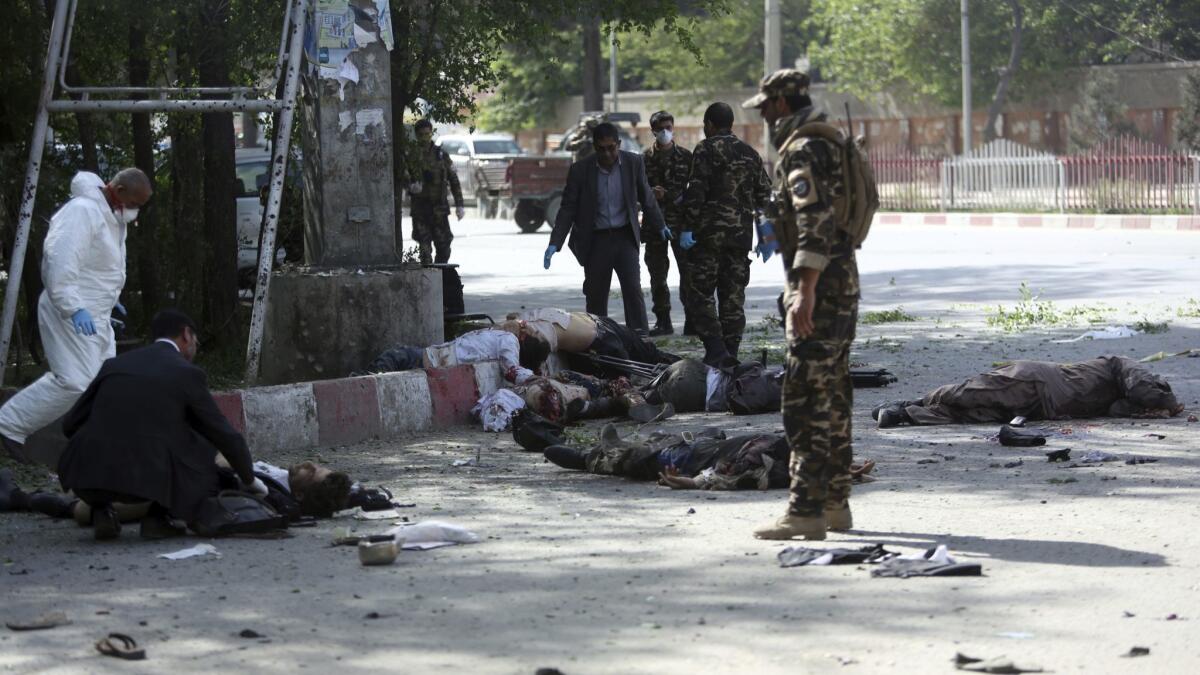Work of slain Afghan journalists provided intimate, wrenching look at country’s long conflict

Their story was the story of their country, and they died telling it.
At least nine Afghan journalists were killed Monday in a bombing in Kabul, and a 10th died in an unrelated attack in the country’s east, according to Afghan officials and media organizations. It was thought to be the single deadliest day for journalists in the course of the 17-year Afghan conflict.
The slain journalists were among at least 31 people killed in several attacks Monday in Afghanistan, where violence is often a gruesome backdrop to daily life. The Kabul attack, a dual bombing for which Islamic State claimed responsibility, highlighted growing insecurity even in heavily secured areas of the capital.
It was not the first time in Afghanistan that those rushing to the scene of an explosion — journalists, medics, emergency personnel — were deliberately targeted by a cruelly timed follow-up blast. Monday’s thunderous second bombing came after a crowd had already gathered near the scene of the first strike. According to some reports, the attacker was wearing a press vest and carrying a camera.
Some of the journalists who died were new to the profession, while others were seasoned veterans. Some were only children at the time of the takeover by Taliban militants and the 2001 U.S.-led invasion that followed the Sept. 11 terrorist attacks; others, such as Shah Marai, the chief photographer for Agence France-Presse in Afghanistan, had witnessed the long arc of the conflict, joining the agency as a driver as U.S.-led forces and Afghan fighters were toppling the Taliban.
But in contrast to the euphoria of that time, the Afghanistan conflict has since settled into a grinding slog in which the militants gain more territory with each passing year, and civilian deaths mount as attacks like Monday’s grow bolder.
The slain journalists represented a mix of international news organizations — AFP, the BBC — and local outlets such as Afghanistan’s Tolo television. One of them, newly minted producer Maharram Durrani of Radio Free Europe/Radio Liberty, was part of a small cohort of female broadcasters, photographers and reporters who in recent years have helped change Afghanistan’s largely male press culture.
In Afghanistan, families tend to be large and close-knit, and the journalists’ deaths, like nearly all in the conflict, had a devastating ripple effect. Marai left six children, AFP reported. Tolo News cameraman Yar Mohammed Tokhi, was to have been married within weeks.
The journalist who died in the eastern city of Khost was Ahmad Shah, a 29-year-old working for the BBC’s Afghan service. He was fatally shot on his way home, the Afghan Journalists Safety Committee said. The BBC called it a “devastating loss.”
The deaths point to heightened peril for journalists across the globe. The Paris-based group Reporters Without Borders said 50 professional journalists were killed last year, together with seven “citizen journalists” and eight media workers.
Syria and Mexico were the deadliest venues, while China and Turkey were the world’s foremost jailers of journalists, the group said, citing threats including increasing authoritarianism and targeted killings of reporters investigating corruption and crime.
As in conflicts everywhere, the work of local reporters in Afghanistan provided an unmatched window into the war’s effects, and many social-media tributes pointed out that international journalists could not operate without their Afghan colleagues’ knowledge, courage and expertise. As Western news organizations have retreated from Afghanistan, more and more of the coverage has fallen to local staffers whose work was often under-credited in the early years of the war.
Many of the journalists killed in Monday’s attack had resisted a narrative of Afghan victimhood, seeking to use their work to offer an engaging, nuanced view of their country and their compatriots.
Marai, the AFP photographer, was known for images that put a human face on a seemingly endless war— a boy cradling a sheep, a child being vaccinated, a man walking beneath a fairy-tale canopy of snow-coated winter trees.
In a 2016 blog post for AFP, Marai wrote about life in Kabul, paying particular tribute to a colleague, Sardar Ahmad, who was killed along with his wife, a daughter and a son, in an attack on a Kabul hotel. He wondered whether the same fate awaited him.
“Every morning as I go to the office and every evening when I return home, all I think of are cars that can be booby-trapped, or of suicide bombers coming out of a crowd,” he wrote then.
In its obituary for the 41-year-old photographer, AFP reported an exchange between Marai and a colleague just before Monday’s second explosion. The colleague, a videographer, was fretting over being stuck in traffic. Marai assured him he was shooting video as well as snapping still photos.
“No worry man,” he wrote. “I am here.”
Twitter: @laurakingLAT
More to Read
Sign up for Essential California
The most important California stories and recommendations in your inbox every morning.
You may occasionally receive promotional content from the Los Angeles Times.










